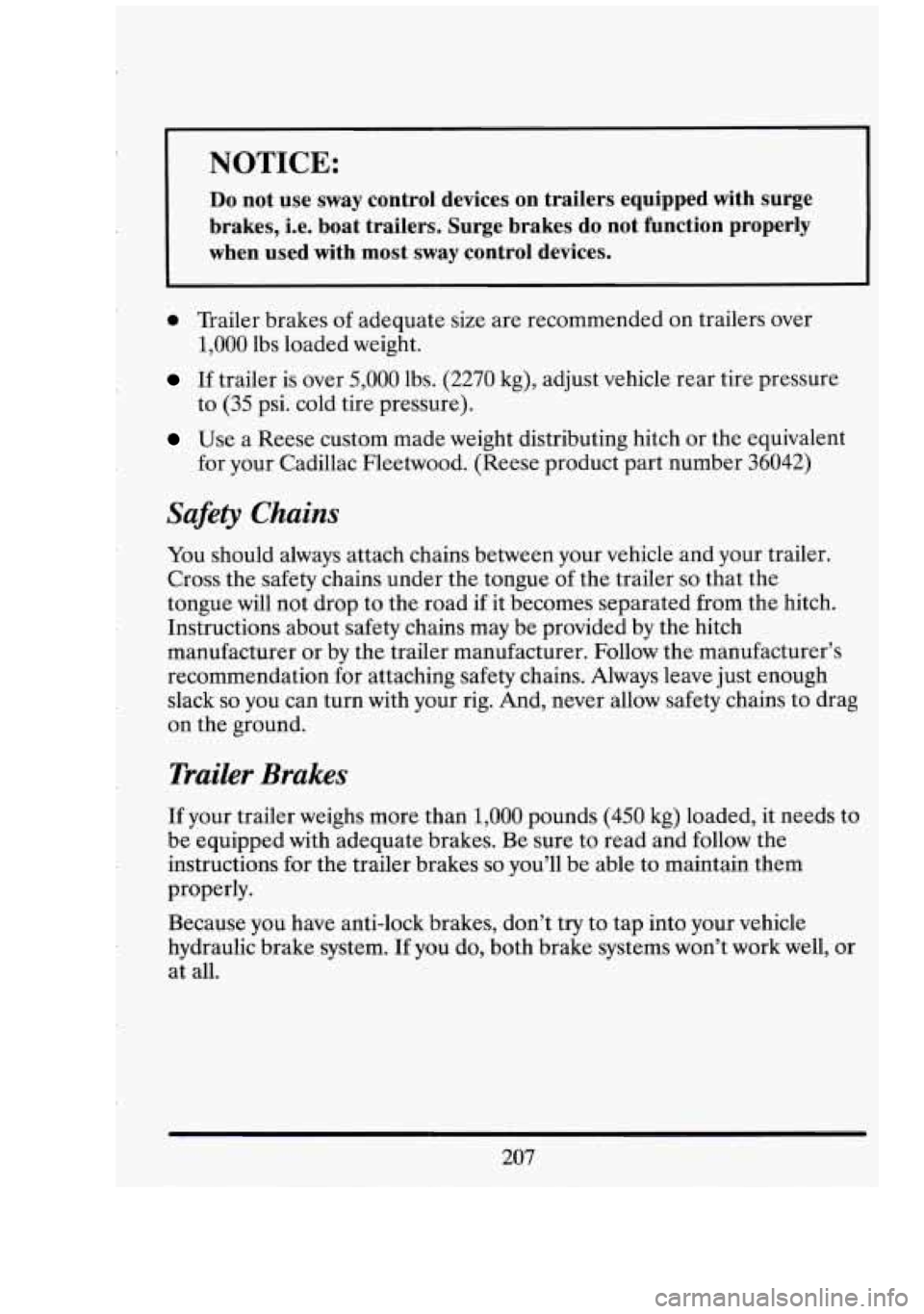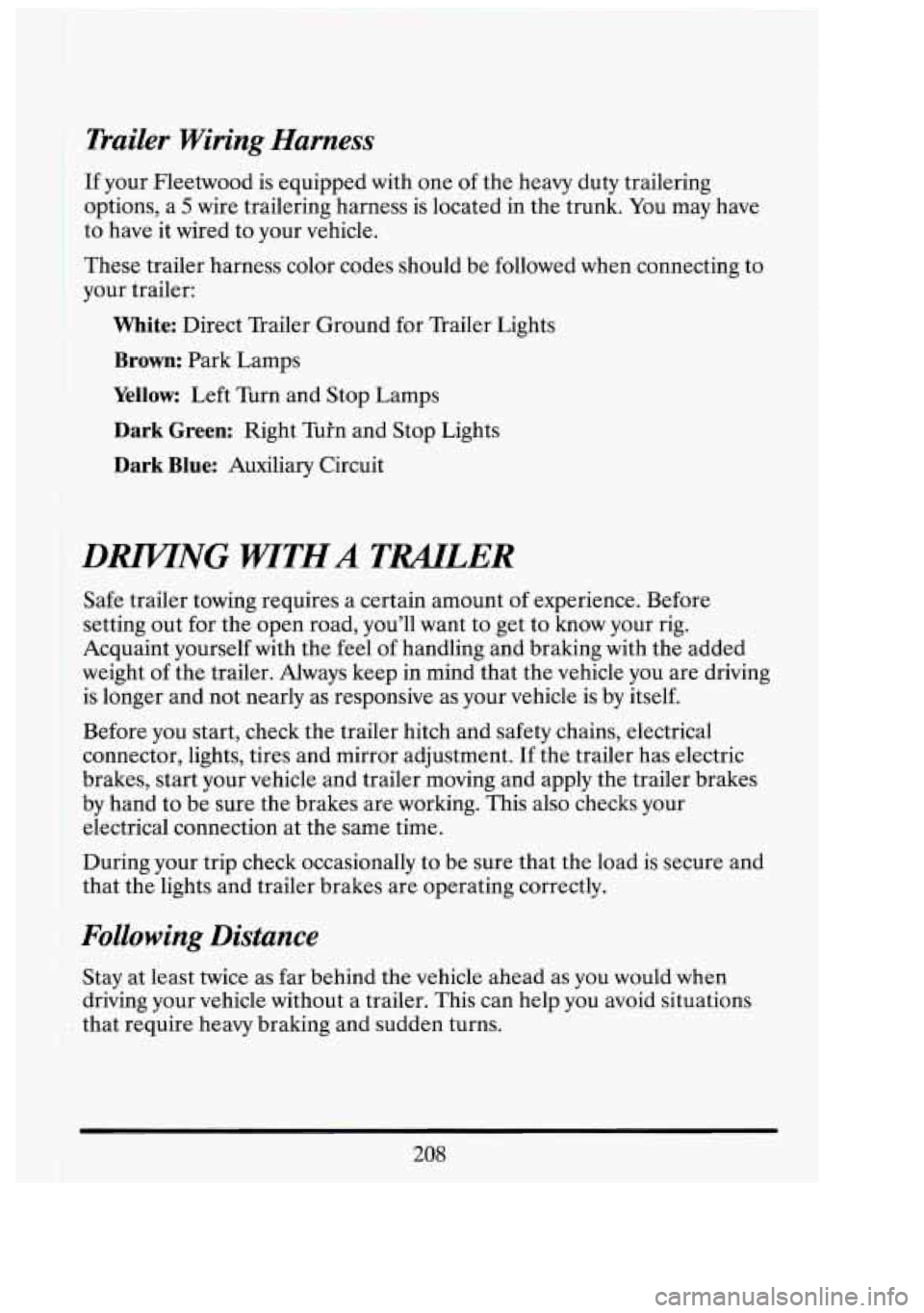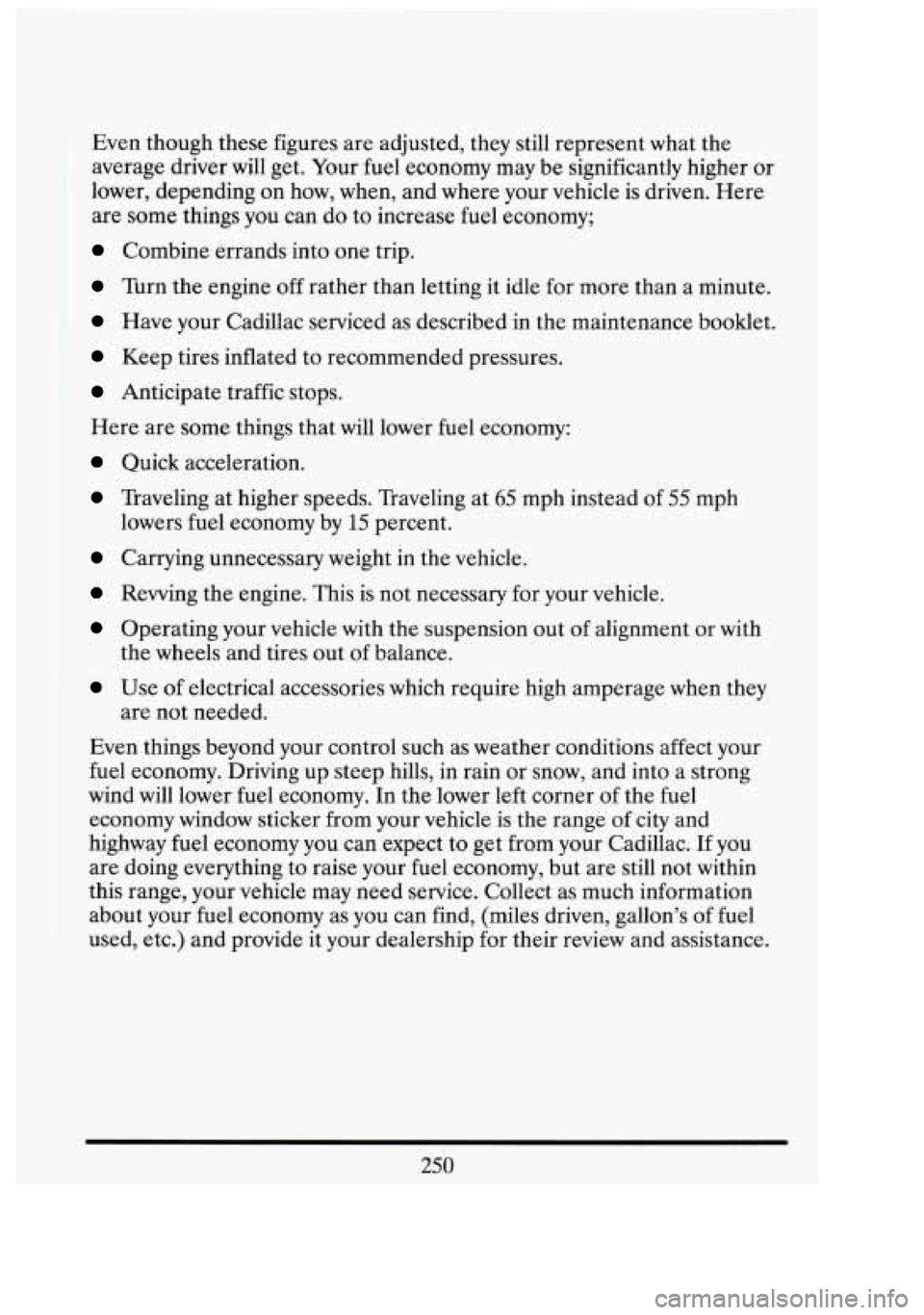1994 CADILLAC FLEETWOOD weight
[x] Cancel search: weightPage 219 of 398

Trailer Hitching Procedure Using A Weight
Distributing (Equalizing) Hitch
(Recommended for loaded trailers weighing 3,000 lbs. to 7,000 lbs.)
Your vehicle is equipped with an Electronic Level Control (ELC) feature.
When hooking up a trailer using a weight distributing hitch, always use
the following procedure:
0
0
0
0
0
Place the vehicle on a level surface without the trailer hitched. With
the ignition off, and all doors closed, allow the vehicle to level
automatically.
Disable the Electronic Level Control (ELC) by pulling
MAXI@
fuse #9 (30 AMP) from the underhood electrical center located on
the passenger side wheel housing in the engine compartment. Remove
the cover to gain access.
Attach the trailer to the vehicle. The trailer tongue should weight
12%
of the total loaded trailer weight.
Level the vehicle with the load leveling spring bars (equalizers).
Leave the fuse out while towing your trailer.
n It
I
I
E'
NOTICE:
Adjusting an equalizing hitch with the Electronic Level Control \
(ELC) system engaged will defeat the function of the load
equalizing hitch and may cause unsatisfactory handling.
Once you have completed towing your trailer, be sure to reinstall the
Electronic Level Control (ELC) fuse.
In Addition
Use two friction sway controls if your trailer is over 5,000 lbs. .(2270
kg) loaded weight, and/or is. over 24'. long..
0 Use at least one friction sway control if your trailer is over 2,000 lbs.
(908 kg) loaded weight, and consider using one for trailers under
2,000 lbs. (908 kg).
ill
i
3
206
Page 220 of 398

r
NOTICE:
Do not use sway control devices on trailers equipped with surge
brakes, i.e. boat trailers. Surge brakes do not function proper\
ly
when used with most sway control devices.
0 Trailer brakes of adequate size are recommended on trailers over
1,000 lbs loaded weight.
If trailer is over 5,000 lbs. (2270 kg), adjust vehicle rear tire pressure
to (35 psi. cold tire pressure).
Use a Reese custom made weight distributing hitch or the equivalent
for your Cadillac Fleetwood. (Reese product part number 36042)
Safety Chains
You should always attach chains between your vehicle and your trailer.
Cross the safety chains under the. tongue of the trailer
so that the
tongue will not drop to the road
if it becomes separated from the hitch.
Instructions about safety chains may be provided by the hitch
manufacturer or by the trailer manufacturer. Follow the manufacturer’s
recommendation for attaching safety chains. Always leave just enough
slack
so you can turn with your rig. And, never allow safety chains to drag
on the ground.
Trailer Brakes
If your trailer weighs more than 1,000 pounds (450 kg) loaded, it needs to
be equipped with adequate brakes. Be sure to read and follow the
instructions for the trailer brakes
so you’ll be able to maintain them
properly.
Because you have anti-lock brakes, don’t try to tap into your vehicle
hydraulic brake system. If you do, both brake systems won’t work well, or
at all.
207
Page 221 of 398

I
Trailer Wiring Harness
I
If your Fleetwood is equipped with one of the heavy duty trailering
options, a
5 wire trailering harness is located in the trunk. You may have
to have it wired to your vehicle.
These trailer harness color codes should be followed when connecting to
your trailer:
White: Direct Trailer Ground for Trailer Lights
Brown: Park Lamps
Yellow: Left Turn and Stop Lamps
Dark Green: Right Tuh and Stop Lights
Dark Blue: Auxiliary Circuit
DRIFTNG WTHA TWLER
Safe trailer towing requires a certain amount of experience. Before
setting out
for the open road, you'll want to get to know your rig.
Acquaint-yourself with the feel
of handling and braking with the added
weight of the trailer. Always keep in mind that the vehicle you are driving
is longer and not nearly as responsive as your vehicle is by itself.
Before you start, check the trailer hitch and safety chains, electrical
connector, lights, tires and mirror adjustment.
If the trailer has electric
brakes, start your vehicle and trailer moving and apply the trailer brakes
by hand to be sure the brakes are working. This also checks your
electrical connection at the same time.
During your trip check occasionally to be sure that the load is secure and
that the lights and trailer brakes are operating correctly.
Following Distance
Stay at least twice as far behind the vehicle ahead as you would when
driving your vehicle without a trailer. This can help you avoid situations
that require heavy braking and sudden turns.
208
I
I
Page 263 of 398

Even though these figures are adjusted, they still represent what the
average driver will get. Your
fuel economy may be significantly higher or
lower, depending on how, when, and where your vehicle is driven. Here
are some things you can do to increase fuel economy;
Combine errands into one trip.
Turn the engine off rather than letting it idle for more than a minute.
Have your Cadillac serviced as described in the maintenance booklet.
Keep tires inflated to recommended pressures.
Anticipate traffic stops.
Here are some things that will lower fuel economy:
Quick acceleration.
Traveling at higher speeds. Traveling at 65 mph instead of 55 mph
Carrying unnecessary weight in the vehicle.
lowers fuel economy
by
15 percent.
Rewing the engine. This is not necessary for your vehicle.
Operating your vehicle with the suspension out of alignment or with
the wheels and tires out
of balance.
Use of electrical accessories which require high amperage when they
are not needed.
Even things beyond your control such as weather conditions affect your
fuel economy. Driving up steep hills, in rain or snow, and into a strong
wind will lower fuel economy. In the lower left corner of the fuel
economy window sticker from your vehicle is the range
of city and
highway fuel economy you can expect to get from your Cadillac. If you
are doing everything to raise your fuel economy, but are still not within
this range, your vehicle may need service. Collect as much information
about your fuel economy as you can find, (miles driven, gallon’s of fuel
used, etc.) and provide it your dealership for their review and assistance.
cl;
31
-1
ra
1-1
ra
250
Page 302 of 398

- LOADING YOUR VEHICLE
OCCUPANTS VEHICLE CAP.
WT.
TIRE-LOADING INFORMATION
FRT. CTR.
RR. TOTAL LBS. KG
MAX. LOADING
& GVWR SAME AS VEHICLE
CAPACITY WEIGHT XXX COLD
TIRE
TIRE SIZE SPEED PRESSURE RTG PSVKPa
F
RT.
RR.
SPA.
IF TIRES ARE HOT. ADD 4PSV28KPa SEE
OWNER'S MANUAL FOR ADDITIONAL
INFORMATION
GEN GME I
IWO labels oflybuf vehicle show how much weight it may properly carry.
The Tire-Loading Information label found
on the driver's door tells you
the proper size, speed rating and recommended inflation pressures for
the tires on your vehicle. It also gives you important information about
the number
of people that can be in your vehicle and the total weight that
you can carry. This weight is called the Vehicle Capacity Weight and
includes the weight
of all occupants, cargo, and all nonfactory-installed
options.
289
Page 303 of 398

MFD BY GENERAL MOTORS CORP
DATE GVWR GAWR FRT GAWR
RR
THIS VEHICLE CONFORMS TO ALL APPLI-
CABLE
U.S. FEDERAL MOTOR VEHICLE
TION STANDARDS IN EFFECT ON THE
DATE
OF MANUFACTURE SHOWN ABOVE.
SAFETY,
BUMPER, AND THEFT PREVEN-
GEN GME
The other label is the Certification label, found on the rear edge of the
driver's door. It tells you the gross weight capacity of your vehicle, called
the GVWR (Gross Vehicle Weight Rating). The GVWR includes the
weight
of the vehicle, all occupants, fuel and cargo. Never exceed the
GVWR for your vehicle, or the Gross Axle Weight Rating (GAWR) for
either the front or rear
axle.
And, if you do have a heavy load, you should spread it out. Don't carry
more than
200 pounds (90 kg) in your trunk
r'tr
ni
L.
290
Page 335 of 398

FLUID CAPACITIES
Auto Trans (4L60) Pan Removal ................... 5 qts. (4.7 L)
Auto Trans (4L60) Overhaul (245mm Torque Conv.)
. . 8 qts. (7.9 L)
Auto Trans (4L60) Overhaul (298mm Torque Conv.) 11 qts. (10.6 L)
Engine Oil
& Filter Change ..................... 5.0 qts. (4.7 L)
Engine Cooling ............................. 17.6 qts. (16.6 L)
Fuel Tank
................................ .23 gallons (87.4 L)
Power Steering
.................................. 2 qts. (1.9 L)
Rear Axle .................................... 4.3 pts. (2.0 L)
Washer Solvent.
............................... 2.5 qts. (2.4 L)
TIGHTEN TORQUE
Spark Plug ................................ 15 Nom (11 lb. ft.)
Oil Filter
.................................. 19 Nom (14 lb. ft.)
Wheel Lug Nut.
.......................... 135 Nom (100 lb. ft.)
Rear Axle Filler Plug
........................ 35 Nom (26 lb. ft.)
Oil
Pan Drain Plug
.......................... 41 Nom (30 lb. ft.)
VEHICLE DIMENSIONS
Shipping Weight .......................... 4410 Ibs. (1999.9 kg)
Wheel Base
............................... 121.5 in (3085 mm)
Length
.................................... .224 in (5696 mm)
Height
..................................... .57 in (145 1 mm)
Width
...................................... .77 in (1952 mm)
Front Tread
................................ 61.7 in (1568 mm)
Rear Tread
................................ 60.7 in (1542 mm)
ti
t
-1
I
322